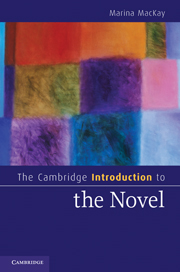Book contents
- Frontmatter
- Contents
- Acknowledgments
- About this book
- Chapter 1 Why the novel matters
- Miguel de Cervantes, Don Quixote (1605, 1615)
- Chapter 2 Origins of the novel
- Laurence Sterne, The Life and Opinions of Tristram Shandy, Gentleman (1759–67)
- Chapter 3 Narrating the novel
- James Hogg, The Private Memoirs and Confessions of a Justified Sinner (1824)
- Chapter 4 Character and the novel
- Nathaniel Hawthorne, The Scarlet Letter (1850)
- Chapter 5 Plotting the novel
- Gustave Flaubert, Madame Bovary (1857)
- Chapter 6 Setting the novel
- Charles Dickens, Bleak House (1853)
- Chapter 7 Time and history
- Virginia Woolf, To the Lighthouse (1927)
- Chapter 8 Genre and subgenre
- Graham Greene, The Ministry of Fear (1943)
- Chapter 9 Novel and anti-novel
- Thomas Pynchon, The Crying of Lot 49 (1966)
- Chapter 10 Novel, nation, community
- Salman Rushdie, Midnight's Children (1981)
- Chapter 11 Concluding
- Notes
- Glossary
- Further reading
- Index
- Cambridge Cultural Social Studies
Chapter 3 - Narrating the novel
Published online by Cambridge University Press: 05 June 2012
- Frontmatter
- Contents
- Acknowledgments
- About this book
- Chapter 1 Why the novel matters
- Miguel de Cervantes, Don Quixote (1605, 1615)
- Chapter 2 Origins of the novel
- Laurence Sterne, The Life and Opinions of Tristram Shandy, Gentleman (1759–67)
- Chapter 3 Narrating the novel
- James Hogg, The Private Memoirs and Confessions of a Justified Sinner (1824)
- Chapter 4 Character and the novel
- Nathaniel Hawthorne, The Scarlet Letter (1850)
- Chapter 5 Plotting the novel
- Gustave Flaubert, Madame Bovary (1857)
- Chapter 6 Setting the novel
- Charles Dickens, Bleak House (1853)
- Chapter 7 Time and history
- Virginia Woolf, To the Lighthouse (1927)
- Chapter 8 Genre and subgenre
- Graham Greene, The Ministry of Fear (1943)
- Chapter 9 Novel and anti-novel
- Thomas Pynchon, The Crying of Lot 49 (1966)
- Chapter 10 Novel, nation, community
- Salman Rushdie, Midnight's Children (1981)
- Chapter 11 Concluding
- Notes
- Glossary
- Further reading
- Index
- Cambridge Cultural Social Studies
Summary
Nobody can work in material of which the properties are unfamiliar, and a reader who tries to get possession of a book with nothing but his appreciation of the life and the ideas and the story in it is like a man who builds a wall without knowing the capacities of wood and clay and stone. Many different substances, as distinct to the practiced eye as stone and wood, go to the making of a novel, and it is necessary to see them for what they are.
Percy Lubbock, The Craft of Fiction (1921)What makes the narration of Tristram Shandy so striking is that we are never allowed to forget that everything we learn reaches us mediated by the idiosyncratic voice of Tristram himself. You could put it more strongly than this and say that the telling of events constitutes the main event, as would later become the case in many twentieth-century novels: “There is the story of one's hero,” Henry James wrote of his novel The Ambassadors (1903), “and then … the story of one's story itself.” That novels are never simply unfolding before our eyes but are narrated from somewhere is one of the most important factors to keep in mind as we read them. Although other predominantly narrative forms such as theater and film have strategies of their own to direct our perceptions and make particular meanings possible, they usually present events as if they are happening before our eyes rather than being “told” to us: unlike the events of a novel, dramatic and cinematic events are enacted rather than narrated.
- Type
- Chapter
- Information
- The Cambridge Introduction to the Novel , pp. 39 - 59Publisher: Cambridge University PressPrint publication year: 2010

